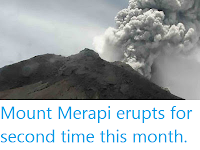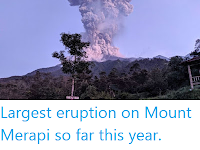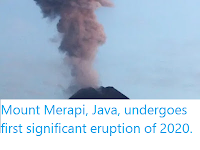The Badan Nasional Penanggulangan Bencana has reported an eruption on Anak Krakatoa, a volcanic island located in the Sunda Strait between Sumatra and Java, Friday 10 April 2020. The eruption occurred between 10.00 and 10.35 pm local time, producing an ash column that rose to about 500 m above the 110 m high summit of the volcano. A number of people have reported hearing loud booms in Jakarta, slightly over 100 km to the east of the volcano, but local authorities do not believe these are related to the volcano as the timing is wrong.
An eruption on Anak Krakatoa on 10 April 2020. José Parra/Twitter.
Krakatau is a volcanic island located in the Sunda Strait between
Sumatra and Java. The volcano famously exploded in 1883, killing over 36
000 people (possibly over 120 000), largely through a series of
tsunamis. This explosion more-or-less completely destroyed the island,
but since then a new volcano, sometimes called Anak Krakatau, has grown
in its place. Anak Krakatau is almost never completely quiet, but goes through periods of greater and lesser activity. An eruption on 22 December 2018 triggered a tsunami which tsunami caused over 430 fatalities, injured 14 000 people, and displaced
33 000 more along the Sunda Strait. The tsunami risk of this area is
particularly high as the coast is very popular with both locals and
tourists and is home to over 20 million people within a 100 km distance
from the volcano.
Debris on Carita Beach in Batan Province, Java, following the 23 December 2018 Sunda Strait tsunami. Reuters.
Tsunamis occur when large volumes of water are displaced by geological
events, such as landslips or Earthquakes, forming waves which spread out
through the surrounding ocean. Like other waves, tsunamis are not
necessarily obvious in deep, open waters, but when they reach shallow or
enclosed waterways can be extremely dangerous. This is because a
tsunami isn't just a wave above the normal sea-level, it is pressure
wave beneath the surface, which is amplified in the enclosed space. A
tsunami reaching the shore is typically
preceded and followed by rapidly shallowing water. Thus people in areas
prone to tsunamis know to evacuate the coast rapidly if the tide
apparently goes out rapidly, since this is likely to be followed by the
tide coming in rapidly. This gives us the English term 'tidal wave'
which is no longer used, since it is inaccurate; the tides are caused by
the gravity of the sun and moon, tsunamis are nothing to do with the
tide. The term 'tsunami' comes from Japan, where earthquakes, and
therefore tsunamis, are common.
How a landslip can trigger a tsunami. University of California, Santa Cruz/BBC.
Krakatau is located to the north of the Sunda Trench, along which the
Australian Plate is being subducted beneath the Sunda Plate, on which
the island sits. As the Australian Plate is subducted it is partially
melted by the friction and the heat of the planet's interior. Some of
this melted material then rises through the overlying Sunda Plate,
fuelling Krakatau and the volcanoes of Sumatra and Java.
The Subduction zone beneath Sumatra. NASA/Earth Observatory.
See also...
Follow Sciency Thoughts on
Facebook.










